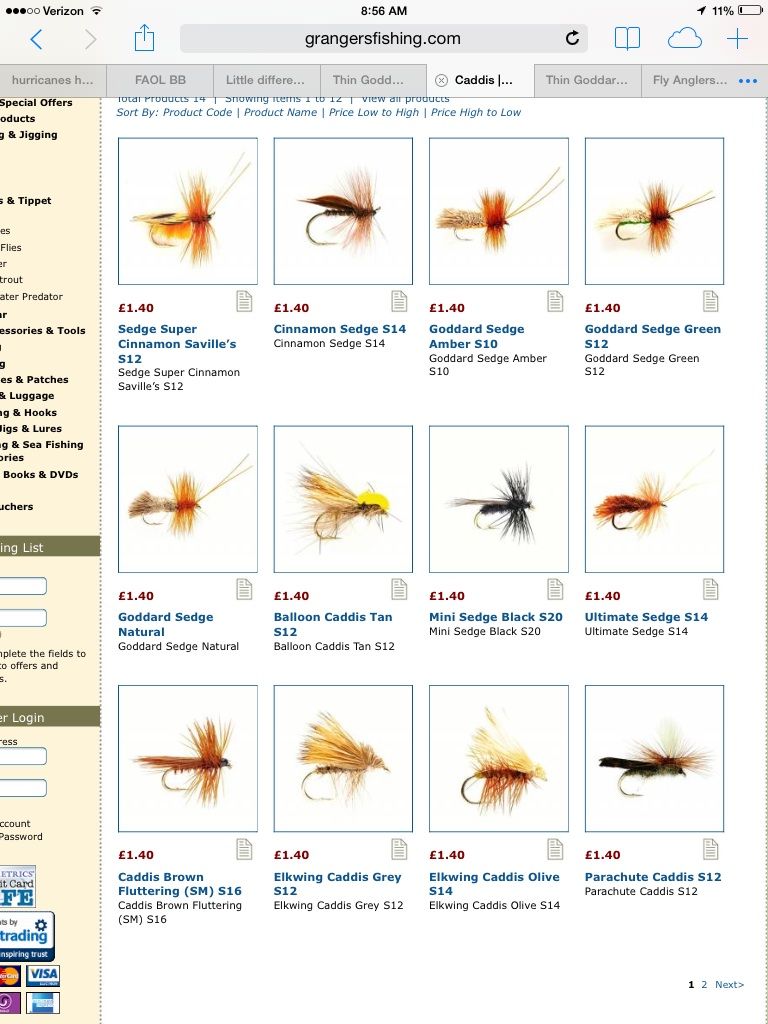

I like the Goddard style caddis as it floats well and is quite visible. I usually omit the antenna and go a little sparser on the hackle. I also like to add some color on the underside with a permanent marker to imitate the body color of the naturals and sometimes trim the hackle flush on the bottom.
Goddard standard form is just about my favorite dry fly to tie and fish... something about it just works for me...
I must admit that I wouldn't recognise that as a G&H. No sign of the dubbed arc chrome wool under the body, hackle not trimmed, then there's that body shape. Not at all like a G&H. How many changes can you make to a pattern before it's no longer the pattern? Missing out a material that forms a major trigger point on the original fly is perhaps a change too far.
Cheers,
A.

Alan,
Reading your comments, I was reminded that the belly of this fly is a separate material then the spun/clipped body. So I just looked up the pattern in a few books and in one, there was a letter to the author from either Goddard or Punyens. The letter mentioned that a pen could be used or a dubbed thread and seemed to imply that either was optional. I did not see any plate or photo of the pattern with the hackle trimmed though. Also, the triangular shape of the original pattern, a caddis with its tent wing in the down position, is a key element. The one in the initial photo is not even close to correct. It's cylindrical or maybe just poorly trimmed? Lastly, I completely agree when you say, "How many changes can you make to a pattern before it's no longer the pattern?" I believe the answer is, when you don't recognize that it is what you are told it is. If you know what a pattern is supposed to look like and you have to do a double take or have a fly identified for you, then that fly is not the same pattern. Example - Change the body of a Red Quill from stripped hackle to stripped peacock and you now have a Quill Gordon.
Allan

Here is a Goddard Caddis as tied by Andre Puyans. He. Was visiting Goddard and Henry when they developed the G&H Sedge. He , being a Western style tier, was much better with spinning deer hair. He offered suggestions on how to modify the original G&H Sedge and came up with this, which he named the Goddard Caddis.....
So, just so you know, the Goddard Caddis is slightly different from the G&H Sedge.
Below is what I believe is the Stillwater version of the original G&H Sedge.
If you look closely, you will see the green fur as the belly of the fly.

Last edited by Byron haugh; 08-10-2014 at 04:01 AM.
That's, the one, with all its problems. Wasn't aware they were different patterns. I often wondered what Cliff Henry had done wrong!
Cheers,
A.

Terry Hellekson, in his massive encyclopedia type book, FISH FLIES, gives a history of this pattern. His description is supported by an accompanying note by Andrew Puyans who describes the recipe and a few slight alternatives. No mention is made of trimmed hackle, and I could not find any reference to a 'G & H Sedge'. There is a photo of the Goddard Caddis on Plate 16.


Allan,
You still don't accept that the G&H Sedge and the Goddard Caddis are/were a bit different in their origin and tying method?
You see, over time, those who didn't know of the variation between the two have pretty much adopted the name "Goddard Caddis" as interchangeable for either the G&H Sedge or the Goddard Caddis and have mostly accepted Andre Puyans' version over the original G&H Sedge.
From Valla's great book "Founding Flies":
If you look at this site, it shows a step-by-step of the original G&H Sedge. I believe he takes this from a book by Goddard reprint of 1977.
As you will see, the original had a green underbelly which, I believe, was seal's fur.
http://thefeatherbender.com/2013/08/...the-g-h-sedge/
A page from a fly shop in London showing their caddis flies for sale. The patterns are called Goddard Sedge and not G&H Sedge............

Last edited by Byron haugh; 08-10-2014 at 06:58 PM.